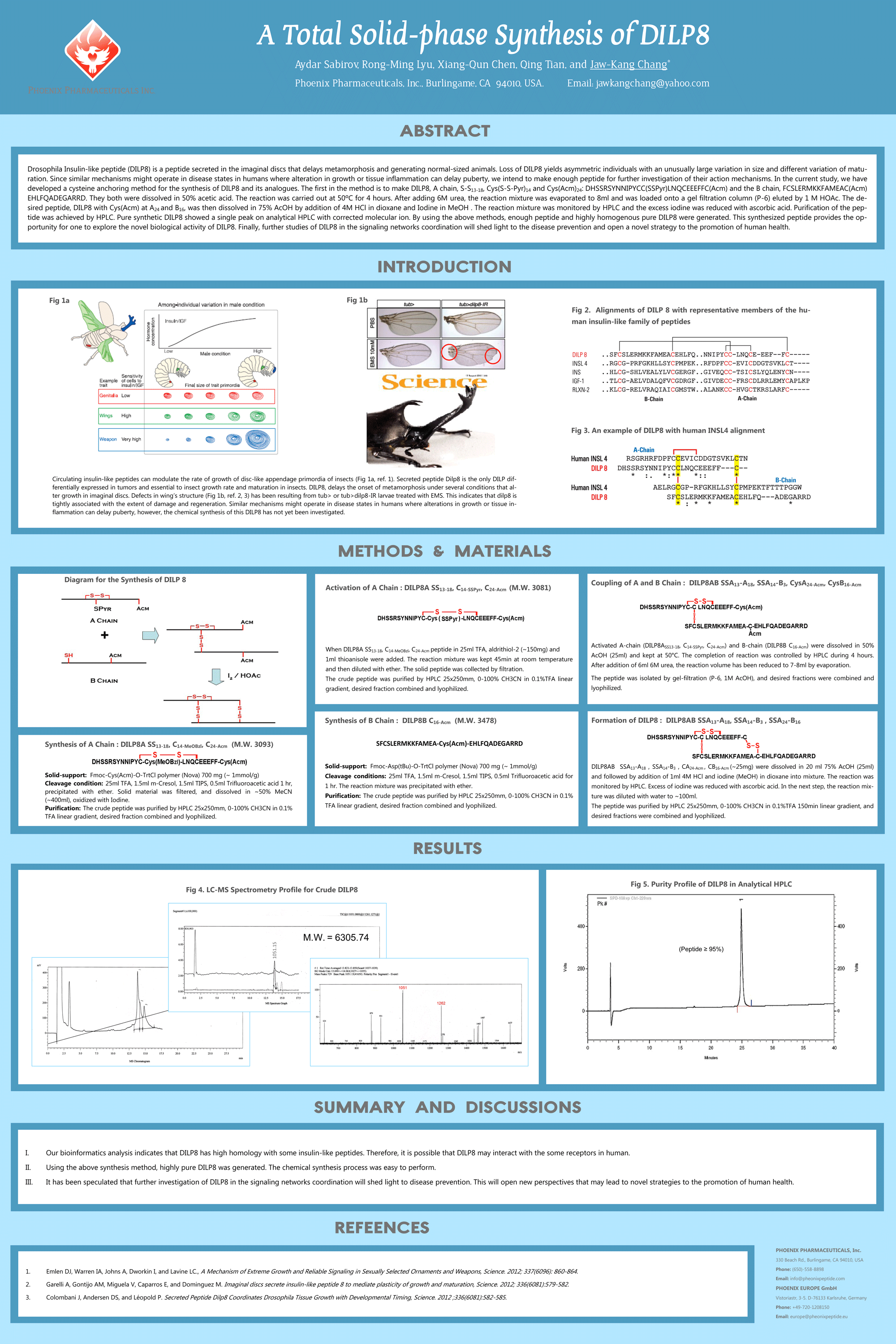The only secreted DILP peptide differentially expressed in tumors, essential to insect growth rate and maturation
Updates coming soon.
In various organisms, including flies, amphibians, and mammals, major developmental transitions such as metamorphosis and puberty are triggered by specific hormones. The requirement for a hormone to proceed to the next stage allows the organism to reestablish the temporal coordination of development between multiple organs that might develop at slightly different rates. Additionally, organisms appear to have evolved mechanisms for delaying these transitions in situations where growth in an organ is abnormal or delayed. New evidence in the fruit fly Drosophila melanogaster indicates that DILP8, a protein of the insulin and relaxin family, delays the onset of metamorphosis under several conditions that alter growth in imaginal discs. Similar mechanisms might operate in disease states in humans where alterations in growth or tissue inflammation can delay puberty.
The imaginal discs of Drosophila represent defined larval tissues that give rise to the subsequent adult appendages. These tissues regenerate in response to damage. When the imaginal discs are injured or show tumor growth, they signal to the rest of the larval animal to slow down growth and delay morphogenesis. Garelli et al. (p. 579, Science, Vol 336) and Colombani et al. (p. 582, Science, Vol 336) now show that an insulin-like peptide, termed Dilp8, is secreted into the hemolymph (insect “blood”) and participates in the communication between growing organs and the endocrine system to adjust the growth program and maturation time. This collaboration ensures that adults attain the normal size and maintain appropriate proportions and symmetry.
Conspecific individuals exhibit similar body size and proportions because they can adjust their developmental timing to compensate for variations in both internal and external conditions during development. In the fruit fly Drosophila melanogaster, the onset of metamorphosis (pupariation) at the end of the third larval stage may be delayed by unfavorable environmental conditions or by tissue damage until the animal has reached a target size. Two groups have identified Dilp8 (Drosophila insulin-like peptide 8) as a secreted signal that coordinates tissue growth with developmental timing in the fruit fly. Garelli et al. noted that dilp8 was increased in expression in eye disc tumors and demonstrated that a loss-of-function mutation in dilp8 rescued the developmental delay caused by the presence of eye disc tumors or by genotoxin-induced tissue damage. These loss-of-function dilp8 mutants exhibited greater variability in the timing of pupariation and in body size and showed increased bilateral asymmetry compared with wild-type animals. Colombani et al. found that reducing the expression of dilp8 by RNA interference rescued the delay in pupariation exhibited by animals in which imaginal disc growth was delayed by genetic manipulation, but genetic deletion of dilp8 in otherwise normal animals only mildly accelerated pupariation. Both groups demonstrated that dilp8 overexpression delayed pupariation and reduced production of the metamorphosis-inducing steroid hormone ecdysone. Dilp8 was secreted from disc cells in vivo, and Colombani and colleagues demonstrated that secretion was required for Dilp8 function. These findings suggest that Dilp8 is an endocrine signal that regulates developmental timing when tissue growth is delayed as part of a feedback mechanism that enables an organism to compensate for the extra time required to repair or regenerate damaged tissues.
Little is known about how organ growth is monitored and coordinated with the developmental timing in complex organisms. In insects, impairment of larval tissue growth delays growth and morphogenesis, revealing a coupling mechanism. We carried out a genetic screen in Drosophila to identify molecules expressed by growing tissues participating in this coupling and identified dilp8 as a gene whose silencing rescues the developmental delay induced by abnormally growing tissues. dilp8 is highly induced in conditions where growth impairment produces a developmental delay. dilp8 encodes a peptide for which expression and secretion are sufficient to delay metamorphosis without affecting tissue integrity. We propose that Dilp8 peptide is a secreted signal that coordinates the growth status of tissues with developmental timing.
Developing animals frequently adjust their growth programs and/or their maturation or metamorphosis to compensate for growth disturbances (such as injury or tumor) and ensure normal adult size. Such plasticity entails tissue and organ communication to preserve their proportions and symmetry. Here, we show that imaginal discs autonomously activate DILP8, a Drosophila insulin-like peptide, to communicate abnormal growth and postpone maturation. DILP8 delays metamorphosis by inhibiting ecdysone biosynthesis, slowing growth in the imaginal discs, and generating normal-sized animals. Loss of dilp8 yields asymmetric individuals with an unusually large variation in size and a more varied time of maturation. Thus, DILP8 is a fundamental element of the hitherto ill-defined machinery governing the plasticity that ensures developmental stability and robustness.
Related Products

Social Network Confirmation